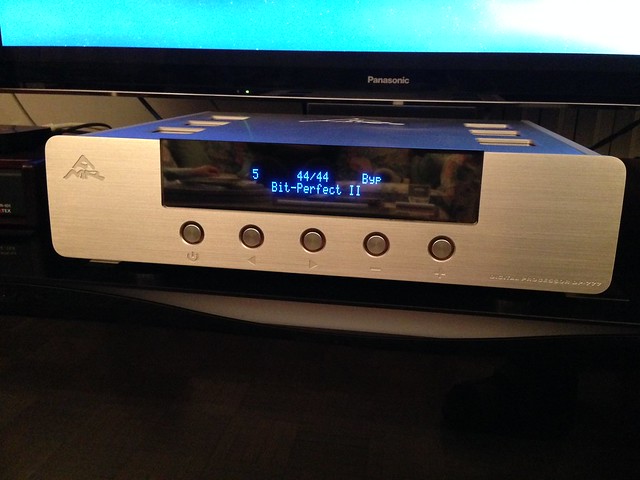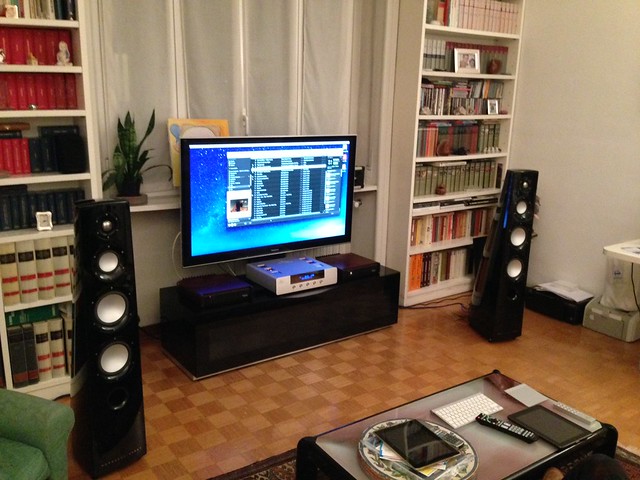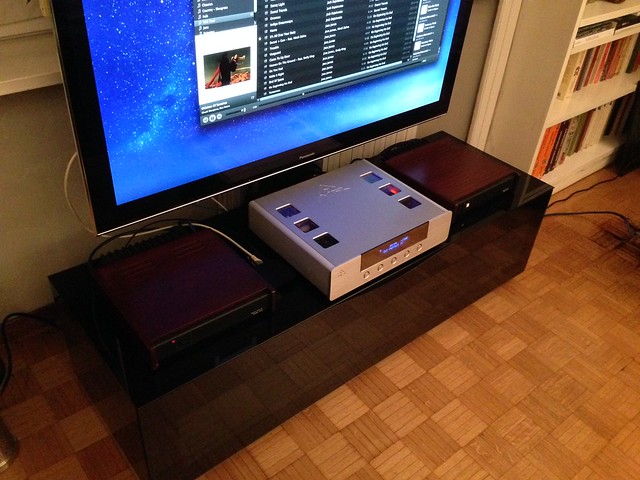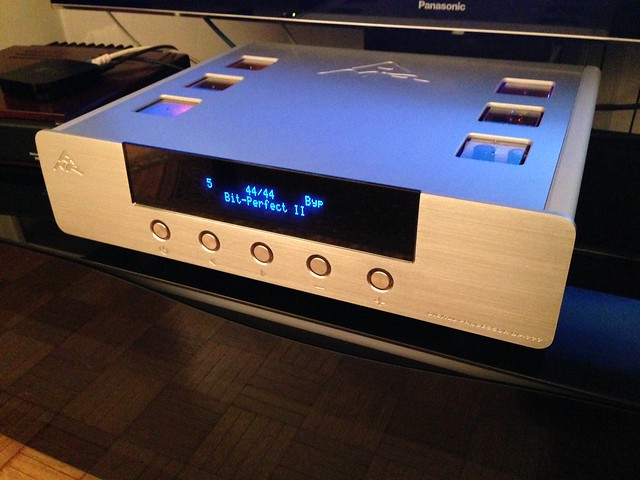Here is my take on the AMR DP-777 DAC, which I have been listening to for several month, and mentioned in various of my latest articles.
AMR has been (co)founded by Thorsen Loesch, one of the people mainly involved in studying the Philips TDA1541 DAC chip through the years, which is usually regarded as one of the very best 16-bit multibit chips.
Loesch has written a handful of articles and posts on several forums, including DIY audio forums.
The current AMR top product, the CD-77 cd player, does use the TDA1541 multibit chip.
The second tier used to be the CD-777. The DP-777 is their only DAC (which would suggest that one day there might be a DP-77, but right now I wouldn’t hold my breath for it).

Technicalities in Short
The AMR DP-777 uses 3 boards: one is for the USB input (customized XMOS receiver), one with the two DAC chips, DSP, and reclocker, and one is the mainboard, where the psu is as well.
The two dac chips are a Philips 16 bit DAC, which is described as ‘the closest multibit chip’ to the 1541 that’s currently in production, and optimized for a custom bitperfect implementation (Bitperfect II filter); the other is a Wolfson 32 bit chip, optimized for high resolution music (and particularly optimized with the Organic HD digital filter).
The user can choose which of the two DAC boards they want to use, not necessarily related to the music bitrate.
For this review, I will start with observations that usually pertain to the ‘conclusions’ section, and then describe the sound more thoroughly.
In a Nutshell
The AMR is the best DAC I have ever heard personally. It basically means it is better than the Metrum Hex and the upgraded Museatex Idat-44 custom DAC (with or without battery). It also means that I haven’t heard the MSB Analogue yet. Nor the Phasure. Nor I have designed anything yet (it could actually never really happen).
I have read tons of comparisons about the AMR DP-777. They often call it ‘mellow’. Mellower than the Msb Analogue, it’s a recurring word.
The thing is, the USB input of the AMR, which most of these people use as main input, is a weird beast. It ‘scales’. It means it’s excessively sensitive to what’s upstream (starting with usb cables) to be called objectively good. Personally I think a USB receiver is good when it’s insensitive to a fragility point like a cable. But still, this point of fragility in the AMR can be overcome with few hundred Euros, with a JCAT (cheapest entry point, costing 300-350 Euro new). It’s about 1/10 of the total source cost.
I am not mentioning the RAL cable, here, because it’s been showing some problems and I am waiting for the manufacturer to replace it.
Anyway, putting a JCAT in the AMR is like “putting an AMR inside the AMR”.

Now, the real impressions.
Test Environment
Our main test system has involved Mordaunt Short Performance 6 speakers with Electrocompaniet ECI3 integrated amplifier (used bypassing the AMR preamp function) and Meitner MTR-101 monoblocks (used with the AMR preamp). Stax SR-007 Mk1 (two pairs) with SRM-007t amplifier. Other stuff we tried lately involved Aude’ze LCD-2, Adam A5x. About 6-7 months ago I was using a friend’s unit, with upgraded Babystax, Audio-Technica AD2000, Aude’ze LCD-3.
The main impressions relate to the speaker system and Stax system, since these are the two most revealing and least coloured system to do any assessment.
My music taste (and the resulting listening tracks) ranges from John Cale’s works (Hobosapiens, Last day on earth…), Velvet Underground, Peter Gabriel, Brian Eno, Fabrizio De Andrè (a local songwriter and poet), Herbie Hancock, Shostackovic, Mahler, Talking Heads, Violent Femmes, and any other artist you can find in my ‘about’ section.
Sound of the AMR
I admit beforehand that I hate that something good sounding must also be expensive. I’d have much preferred if Idat44 or Metrum Hex, both cheaper, could sound better than the AMR. In any case, the AMR manages to be more neutral and enveloping than both.
The AMR DP-777 has more neutral midrange than the Idat dac, while still being vivid and slightly forward. It’s also warmer and has smoother highs than the Hex. The AMR manages to sound very relaxing, enveloping, it captures the listener with its strong musicality, and keeps detailed subdued, never calling attention. The Hex, while not having digital glare either, is slightly brighter overall. It was especially brighter with Stax headphones, than the Idat44.
The AMR lets the listener care much less about details than one usually does when listens to music. This mostly happens with the cheaper cables (we did some comparisons in another article).

With the JCAT cable (and the RAL, although I am currently going by m.emory), things change significantly. In fact, listening with the JCAT usb cable makes you start noticing that, before it, the AMR was ‘not detailed enough’. In fact, the sound becomes much more toe-tapping, much more rhytmical, lively. A layer of ‘mellowness’ and relax gets lost, but the sense of involvement becomes much higher. It’s either the usual ‘curtain’ which gets removed, or the listener who goes up on the stage and becomes part of the event. I am puzzled why usb cables, with their shielding and techniques to reduce jitter, can change the sound so much. The AMR is extremely sensitive even to swaps among cheap usb cables. Certain cheap cables are much worse than others, and others are particularly good.
The details, presence, sense of space all get wider and much better. In fact, the sound signature changes and one cannot talk about it being so mellow as before, but the sound is still addicting and extremely pleasant. It gets a bit closer to the Hex ‘on caffeine’ presentation, but keeps warmer and with more tuneful highs. The midrange is more open, and environment sounds, very often, make the listener turn his head expecing something happened out of the window. This is a recurring theme, with high-end audio, but I never heard these events occurring so often as with this combination.
The ‘sparks’ and details are much more clearly show in the space between speakers, than with less engineered USB cables.
The bass is tight and reaches ‘deep enough’. That’s the only thing where the AMR and the Hex fall short to the Museatex Idat-44 DAC, which has a much stronger deep bass rendition than any other DAC I tried, especially when using a wall psu.
There are tons of information about the Philips DAC chip (Bitperfect II) versus the Wolfson DAC. I will limit myself in agreeing that the Philips chip is warmer, more musical and I tend to use it most of the time. It’s the chip optimized for 16-bit/44.1 kHz playback. The Wolfson DAC is more optimized for high resolution music, and slightly less analogue sounding… still, I am surprised because it’s still quite warm and involving, probably because of the DP-777 output stage.
I think the preamplifier is good, although it seems to lose some of the overall body. I think it’s usable in a high-end setup, and apparently, a new set of tubes is coming with an upgraded version of the DAC, the AMR DP-777 SE.
A few months ago, I also tested its coaxial input through Audiophilleo, versus Acoustic Revive USB twin cable; I had also tried the Hiface 2 converter with the Belkin Synapse Platinum coaxial cable. In both cases, I remember that the DAC sounded at its best with the Acoustic Revive USB, being both fuller and more natural, while it sounded a bit emptied with the Audiophilleo, and slightly slower with the Belkin out of the Hiface usb pen.

Conclusions
What I mainly think of the AMR DP-777 is that it’s a great purchase in the price range. The Metrum Hex is my favourite unit at 2800 Euro, and the AMR DP777, with a price tag of 1000-1300 Euro more, it offers a noticeable step up in sound and also functions as a preamplifier.
The XMOS USB receiver leaves me a bit puzzled, because of its big sensitivity to USB sources and cables, which would suggest it could have been made better; this contrasts to the fact that I could obtain the best sound out of this DAC through this very input, with tye best cables.
This DAC is the best ‘analogue sounding’ kind of DAC I have had the pleasure of owning, and one could optimize the purchase by using its preamp and saving up on external amplification.
Personally, I plan to match it with a Moscode 402au, which is a hybrid power amplifier.
Further updates will come when I will have it upgraded to the SE board, which offers improvements on the digital front.
It also seems that DSD playback will be natively supported with a further upgrade later in time (about one year from now).


